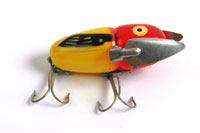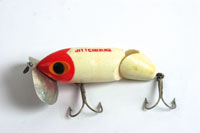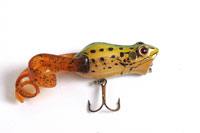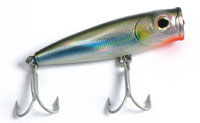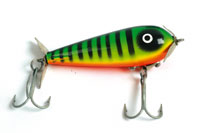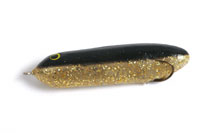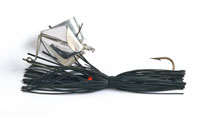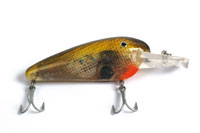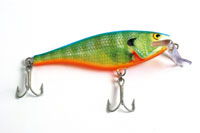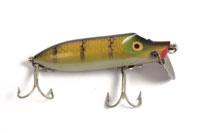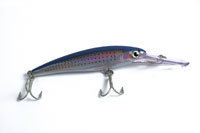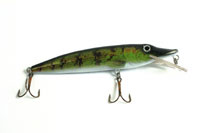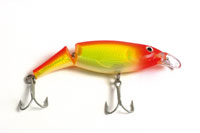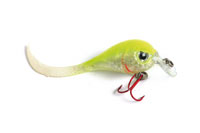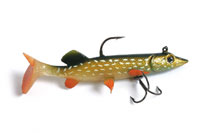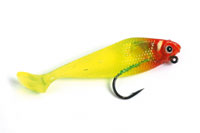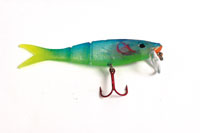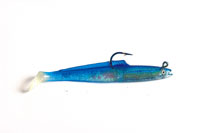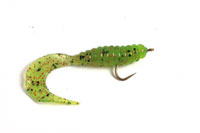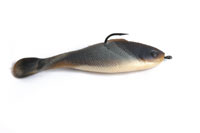What’s The Best Type Of Lure For Perch?
To tackle shallow water venues a small spinner is ideal. There are many makes on the market, such as the Mepps patterns and the Rapala Blue Fox Vibrax lures, that can be fished up to depths of four feet.
Perch are inquisitive creatures and will react to the splash made as the lure lands although they may not attack it.
Once you start to work the lure don’t just draw it back in a straight line. Keep the rod tip low, move it from side to side every so often and change the rate of retrieve. But don’t stop as this will cause the fish to abandon the chase.
Our experts recommend that you try a spinner that omits a buzz-type sound as it travels through the water. Spinners with a bell-shaped body that surrounds a knurled brass barrel are very popular as the lure will rattle as the bell rubs against it.
Perch also seem to go for spinners with red wool or something similar attached to the shank of its hook. This gives the lure added realism as the wool looks like the tail of a small roach or rudd as it moves through the water.
Deep Water Perch Lures
For tackling deeper venues our experts suggest you have a look at some of the modern soft, plastic lures that are now readily available from tackle shops.
Unlike the shallow water lures these need to be fished in an aggressive manner where the lure is first drawn slowly through the water before it’s jerked to give the impression that it’s a sick or injured fish.
According to our experts the best patterns for this style are the so-called kick-tail type of lure, which has a soft, rubber, curly tail that wiggles brilliantly when retrieved. A popular choice is the Storm Wildeye Curltail Minnow, a lure that comes in a variety of wacky colours.
Can You Target Chub With Lures?
Yes, and although chub will take a small, shallow-diving, plug-type lure, the best and most exciting way to fire the predatory instincts of the fish is to use a surface lure under overhanging trees and tight to rafts of weeds.
Chub that live close to these features will investigate anything that drops into the water to see if it’s edible, so a small, floating, insect-like lure that can be made to act like a grasshopper or caterpillar struggling in the surface tension of the water can be deadly, especially in the warmer months.
Lure fishing for chub is not that popular in the UK, but if you fancy a change from the usual float or feeder fishing tactics our experts have identified lures, such as Crazy Crawlers and Creek Hoppers, as those which get the best results.
What Are The Best Zander Patterns?
Fast-sinking lures are the best choice for targeting zander as you want them to crash hard into the bottom of the river.
Sinking lures similar to those used for perch can be used, but you can also use the floating, deep-diving types that have a distinctive tight, rapid wobble as they move down through the water. These are fished using the sink and draw method, but you need to wind down quickly so that the lures hit the deck before allowing them to drift upwards and repeating the action. Our experts suggest you use a pattern like the Rapala Down Deep Husky Jerk, a slim-shaped lure that has a large, shallow-set vein and dives sharply as you crank the line.
What Are The Best Surface Pike Lures?
On shallow venues there’s nothing more exciting that watching a pike leaping out of the water as it takes a large popper, imitation frog or similar pattern that you have been fishing over weed beds or close to reed-lined margins.
Popper lures are best fished by jerking them across the surface where the concave-shaped head creates a disturbance and a ‘plopping’ sound that attracts the fish.
You cannot miss the take as the surrounding water will explode when the fish hits the surface. It’s much the same when you fish a floating imitation, like a frog or mouse, but these are best fished in short jerks to mimic the natural swimming movements of frogs and such like.
What Are Effective Shallow Divers?
Moving away from the marginal features and into the open water where the near shelf drops away, we find possibly the best location to target patrolling fish that can also hold station for a long period.
Buoyant, shallow-diving plugs and imitations, each of which has a dumpy, downward-pointing vein that imparts loads of disturbance as it travels through the water, are the best for covering the area.
These are designed to swim down to around nine feet, depending on the speed at which they are retrieved, and can be fished by continually winding in or using sink and draw tactics, letting the lure come to the top and then cranking the handle to get it to dive down again. Indeed, these types of lure are called ‘crankbaits’ in the USA.
Our experts have had great success with Rapala’s Shad Rap, both the Shallow and the Super patterns that come in loads of colours.
Deep Divers
Large gravel pits, reservoirs and massive waters, like those in the Lake District, require deep-diving lures that allow the angler to fish in depths of up to 25 feet or even deeper. To be honest, if you are looking to fish lures this deep it’s more than likely that these will be fished from a boat; they can be trolled using a number of rods with deep-water lures that work at different levels.
If working the lure yourself heavy spoons fare well in these circumstances. Let them sink to the bottom and then draw them off the bottom before letting them sink again.
If you aren’t permitted to troll from a boat, but still have a depth of water that normal lures could not cover, it’s also well worth trying a pirk or large spoon like those from Kuusamo.
These are heavy, solid metal lures that you fish vertically under a boat or a short cast away from it. Once the required fishing depth is reached you then lift and drop the rod to impart a rise and fall action that fools a predator into believing it’s a weak or dying fish. For those familiar with cod fishing it’s a similar style.
Does Size Matter?
Yes, if you want to fish at depths of over, say, 10 feet. Small lures are fine for fishing shallow venues but you will find that they have a maximum limit before they level out above what would be considered as the ‘action zone’ in deeper venues. Big lures get down fast and deep, so you are able to cover a predator’s patrol area.
Don’t be afraid to fish big, even in shallow water, as a small pike will readily take a plug or soft, plastic lure that’s as big as a 1lb roach.
The most important factor is how you fish it, so that it gains the attention of the predator. A foot off the deck if fishing deeper water will bring the best results say our experts.
Is Rod And Reel Choice Important?
Absolutely! If you use a short rod of up to six feet long then a baitcasting, multiplier-type reel is perfect for casting and working lures that don’t have to travel too far. Once you move on to longer rods then a standard fixed spool reel will allow you to cover greater distances on larger venues.
If you are trying a method known as ‘jerkbaiting’, in which you have to impart the movement into a large wooden lure, then a very stiff rod is critical.
Mono Or Braid?
Our experts all agree that it has to be braid every time. As it has minimal or no stretch you can feel every vibration as the lure moves through the water. You can also feel it as it bounces on the bottom, and experience the vicious takes from a predator, if you are fishing a plastic, leaded model. Once a fish is on the angler is in direct contact, so you are able to feel every powerful lunge, twist and turn the predator makes as it battles to escape.
What Are The Best Colour Patterns?
There are hundreds of lures of every conceivable shape and size available, including many in the United States, which are successfully used for targeting bass. Many of them are highlighted on these pages.
However, our experts have put their heads together and come up with some styles that they say should be in every predator angler’s box.
Any fish-patterned lure is well worth having, as modern ones look extremely natural and lifelike with the most successful patterns being the perch and pike.
Again on a modern theme, there are a lot of holographic styles that glint in clear water venues and resemble a silver fish catching the light as it swims.
Two of the most popular patterns in the UK are the Red Head, a pearl or white lure with a large red patch on its head, and the Fire Tiger, a lure that has a green and yellow body with black stripes. Our experts also highlight the fact that blue and black lures, although not a popular choice, are also deadly colours, especially in coloured water and at night. Remember that a predator is usually looking up at your lure, so the stronger the silhouette it creates against the skyline the better.
Why Do Some Lures Only Have A Single Hook?
These lures are for fishing directly on the bottom and they act like a small fish that is grubbing around for food. If a treble hook was located on its belly it would catch all the weed and detritus that congregates on the deck; therefore, a single hook located on its back remains clean so you can get a positive hook hold when a fish is snared.
These lures need to be fished very slowly so that you create a cloud that attracts predators and fool them into thinking it’s a small fish that’s feeding.
These lures are great for fishing commercial fisheries where there are shoals of small silver fish and big perch, which are largely ignored by the carp bagging visitors and silver fish anglers. They can also be very good for zander in the cooler months.
Ludicrous Lures
They come in crazy colours and shapes, and possess even crazier names, but the tcf team is here to guide your through the lure fishing minefield and help you put bigger predators on the bank.
Surface Sizzlers
Seven styles of top-water lure to help you enjoy some explosive predator action.
|
|
||||
|
|
||||
|
|
||||
|
Spoons And Spinners
Here’s tcf’s guide to the various pieces of metalwork on the market designed to catch more fish.
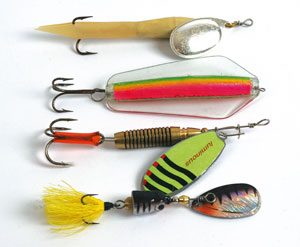 Blade Spinners
Blade Spinners
These have a metal blade that revolves around a central shaft, creating a flash of colour and a fish-attracting vibration that can be felt right through the rod as it is retrieved. The shaft holds a barrel which acts as casting weight. The shape of the blade governs how far from the shaft the blade spins – a 30-degree blade spinner will fish deeper than a 60-degree one. There are more of these than you can shake a stick at, some carrying feathers on the treble.
Mepps Aglia (top): Made American magazine Field and Stream’s list of the top 50 lures of all time. There are several patterns, some including rubber tails or fish and others holding feathers.
Tasmanian Devil (second from top): A bit different, these have a double plastic blade that spins around a long central shaft. Has a good casting weight and can be retrieved, trolled or jigged.
Cora Z Vamp (third from top): Has a bright blade and decent casting weight. One good feature is easily interchangeable blades.
Vibrax Shallow (bottom): A wide, 60-degree blade means this one fishes shallow. Vibrax blade spinners are designed to create extra underwater vibrations due to a knurling of the barrel.
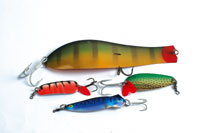 Spoons
Spoons
Metal lures with a rear treble designed to be fished deep on a slow retrieve with the spoon wobbling like an injured fish. Spoons, as the name suggests, derived from actual kitchen spoons when an angler would cut the spoon from the handle, drill a hole at either end, attach a split ring at one end and a hook at the other. Obviously they have got more sophisticated these days.
Kuusamo Professor (top): Large double-hooked spoon which has been used to great effect on trout reservoirs when fished close to the bottom.
Abu Atom (left centre): Very popular single treble pattern for many predatory fish. Comes in a mass of colours.
Blue Fox Esox (right centre): Classic spoon pattern with a red flag on the rear VMC treble, it has a wide swimming action designed for a slow retrieve. Comes in six patterns.
Toby (bottom): Non-symmetrical body form makes the lure flutter on retrieve, while a life-like fish design and 3D eyes give added attraction.
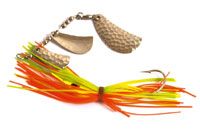 Spinnerbait
Spinnerbait
Classic single hook lures carrying a weighed head with the hook covered by a multi-coloured plastic skirt, and an offset wire carrying one or more fish-attracting blades. A single hook means it can be retrieved slowly along the bottom without snagging, which makes it ideal when predators are deep and sluggish.
 Pirk
Pirk
A heavy metal lure, usually chrome-plated, with a swivel at one end and a strong treble at the other. A specialised lure in freshwater, although commonly used at sea, it’s worked in a jigging fashion in deep water close to the bottom and is something you might use on trout reservoirs that allow pike fishing, loughs or lochs.
Shallow And Deep Divers
A look at some of the bright and beautiful plugs you can buy, and what they will do to catch you more fish.
|
|
||||
|
|
||||
|
|
tcf Top Tip
A floating plug with a long, straight vein is a deep divers when retrieved, whereas a plug with a downward pointing vein will be a shallow diver.
Plastics And Jellies
It’s a modern world, so we’d better look at a selection of new-world lures, including lead-loaded rubber imitations and soft plastic grubs.
|
|
||||
|
|
||||
|
|
||||
|
![]()



